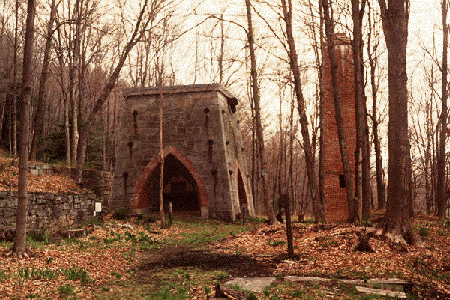

-p. 23 - History- The Mine Hill of today is a haven for wildlife and a place for humans to escape from the pressures of urban life. However, the observant visitor will soon note that this has not always been so. In the latter half of the 19th century Mine Hill was no island of nature, but a busy, noisy, and smoky industrial center. The traces of man's quest for profit cover the hill, from clues as obvious as a blast furnace and huge heaps of quarry rubble to signs as subtle as a cluster of young hemlocks in the middle of a hardwood forest.
Where Highway 67 now crosses the Shepaug River a small community formed around the mining and quarrying activities. This thriving little town once supported a post office, a general store, a school, a lumber yard, a coal yard, a creamery, a hattery, a cigar factory, a brass factory, a hotel, several boarding houses, a bar, and a railroad station....
This little town now survives only in the memories of the area's oldest residents. Others know the word "Chalybes" merely as the name of a small road and do not realize that the name of this vanished town refers to an ancient Asian tribe of ironworkers and to the iron ore that provided the original reason for the town's existence.....
"Mine Hill," that section of Roxbury which has been intermittently mined at various times since before Revolutionary days, and for various minerals.....The Spathic, or sparry oil, is the name given to any of the various non-metallic minerals which are usually cleaveable and lustrous.
Mine Hill was one of the very few places in this country where this particular ore was used in the making of so-called German steel. Its advantage is that steel is made from it directly, being obtained from one operation from the pig.
....the Shepaug Spathic Iron and Steel Company.....was formed in 1861 with a smelting furnace and a mile of track to the mine. ....In 1867 the company was so encouraged by its success that the works were moved to Bridgeport where they operated for a atime. But the cost of smelting and operating on the steep mountainside proved too great and the project was abandoned. What really brought the project to an end was the scheme of the new superintendent to change the furnace from cold blast to hot blast; production dropped, the furnace became chilled and an unmelted mass of ore, 30 tons in weight, called a "Salamander" lay in the bottom of it as congruously as a bride's first homemade bread.
That was the end of the mining settlement.....Waste stone from the quarries was used for stone walks and doorsteps for many houses in surrounding towns...shipped all over the state for churches and other buildings. The library in Roxbury is constructed of Mine Hill stone....
1. America's Valley Forges and Valley Furnaces, by J. Lawrence Pool and Angeline J. Pool, Editor, 1982.
2. Empire Over The Dame, by Kenneth T. Howell and Einar W. Carlson, 1974.
3. Men Of Iron - Forbes and Adam, by Kenneth T. Howell and Einar W. Carlson, 1980.
4. Time and the Land: the story of Mine Hill, by Michael Bell and Diane B. Mayerfeld, 1982.
5. Partial Historical And Archaeological Recording Of The Ore Roasting Ovens: Mine Hill Iron And Steel Making Complex, Roxbury, Connecticut, by Robert B. Gordon and Michael S. Raber, 1984.
6. Mine Hill Furnace Archaeological Study, by Raber and Gordon, 1983.